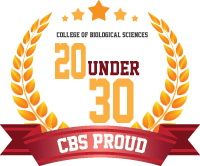
Mamrosh is close to earning her Ph.D. in Molecular and Cellular Biology at Baylor College of Medicine. Working in the lab of Dr. David Moore, she has researched the impact of nuclear receptors on protein folding and degradation.
Her work has included a number of different disciplines. “Currently I’m wrapping up a story in which I've used model organisms ranging from human cell lines to the tiny nematode C. elegans,” she says. “Using such a range of species has allowed me to explore biological ideas more abstractly and creatively, although it’s challenging to assemble everything into a story that can be understood by researchers in a variety of disciplines.” Look for the story in the new open-access journal eLife.
She mentions her work at the University in the lab of Dr. William (Bill) Engeland. “He was a fantastic mentor who invested so much time and energy in training his lab members, and he certainly was my inspiration for pursuing research as a career,” she says.